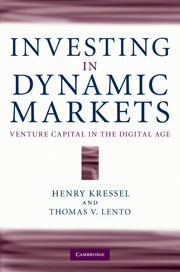Book contents
- Frontmatter
- Contents
- List of figures
- List of tables
- Acknowledgments
- Introduction
- 1 Hot markets, investment waves, bubbles, charlatans
- 2 Financing high-risk businesses
- 3 Venture investing: An uncertain science
- 4 Investing in a transformed market: Telecommunications
- 5 Investing in a transformed market: Semiconductors
- 6 Investing in early-stage technology: The Internet in the 1990s
- 7 Software products and services
- 8 Venture capital: Past and future
- Appendix
- Bibliography
- Index
Introduction
Published online by Cambridge University Press: 06 July 2010
- Frontmatter
- Contents
- List of figures
- List of tables
- Acknowledgments
- Introduction
- 1 Hot markets, investment waves, bubbles, charlatans
- 2 Financing high-risk businesses
- 3 Venture investing: An uncertain science
- 4 Investing in a transformed market: Telecommunications
- 5 Investing in a transformed market: Semiconductors
- 6 Investing in early-stage technology: The Internet in the 1990s
- 7 Software products and services
- 8 Venture capital: Past and future
- Appendix
- Bibliography
- Index
Summary
In early 2009 bestselling author and New York Times columnist Thomas Friedman wrote a column decrying the US government's decision to give failing American automakers billions of dollars in aid. He was writing in the wake of the worldwide fiscal crisis of 2008, the biggest since the Great Depression.
“When it comes to helping companies,” Friedman says, “precious public money should focus on start-ups, not bailouts … Let's make sure all the losers clamoring for help don't drown out the potential winners who could lift us out of this.” He goes on to suggest that top venture capital firms (VCs) pick the winners and allot the Federal funds.
It is clear that the importance of innovation in spurring economic growth and creating new wealth and prosperity is no longer in question. During the American presidential campaign of 2008 there were constant calls for the development of new, revolutionary energy technology as a way of reigniting the economy. But there was plenty of support for this position at the highest levels of government even before that. Here is an excerpt from the 2005 US President's “Economic report.”
Innovation is a primary engine of economic growth. Many commonplace features of modern life, such as personal computers, the Internet, e-mail, and e-commerce, have developed and diffused throughout the economy within a short span of years. Our Nation's growing prosperity depends on fostering an environment in which innovation will flourish.
The innovative process involves the invention, commercialization, and diffusion of new ideas. At each of these stages, people are spurred to action by the prospect of reaping rewards from their investment. […]
- Type
- Chapter
- Information
- Investing in Dynamic MarketsVenture Capital in the Digital Age, pp. 1 - 11Publisher: Cambridge University PressPrint publication year: 2010



